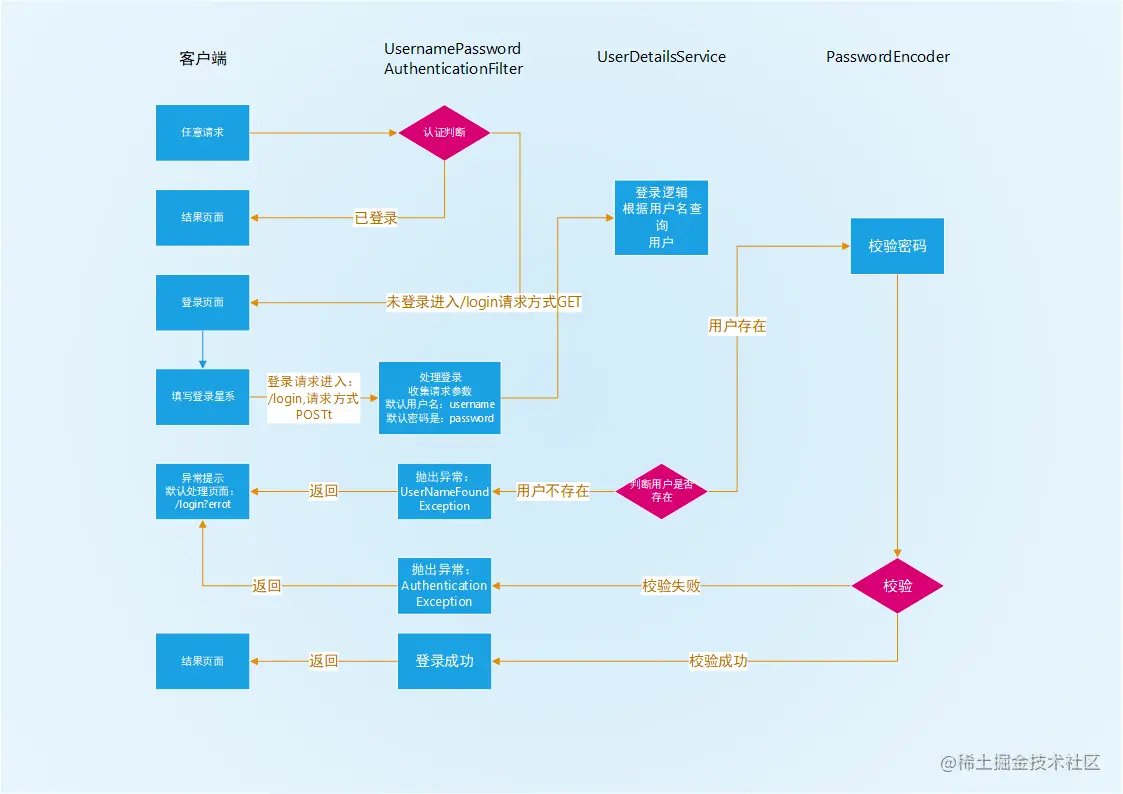Spring Security 最佳实践,看了必懂!
Posted Java技术栈
tags:
篇首语:本文由小常识网(cha138.com)小编为大家整理,主要介绍了Spring Security 最佳实践,看了必懂!相关的知识,希望对你有一定的参考价值。
作者:清茶淡粥酱
链接:https://juejin.cn/post/7026734817853210661
Spring Security简介
Spring Security 是一种高度自定义的安全框架,利用(基于)SpringIOC/DI和AOP功能,为系统提供了声明式安全访问控制功能,减少了为系统安全而编写大量重复代码的工作。
核心功能:认证和授权
Spring Security 认证流程

Spring Security 项目搭建
导入依赖
Spring Security已经被Spring boot进行集成,使用时直接引入启动器即可
<dependency>
<groupId>org.springframework.boot</groupId>
<artifactId>spring-boot-starter-security</artifactId>
</dependency>Spring Boot 基础就不介绍了,推荐下这个实战教程:
访问页面
导入spring-boot-starter-security启动器后,Spring Security已经生效,默认拦截全部请求,如果用户没有登录,跳转到内置登录页面。
在浏览器输入:http://localhost:8080/ 进入Spring Security内置登录页面
用户名: user
密码:项目启动,打印在控制台中
自定义用户名和密码
修改application.yml 文件
# 静态用户,一般只在内部网络认证中使用,如:内部服务器1,访问服务器2
spring:
security:
user:
name: test # 通过配置文件,设置静态用户名
password: test # 配置文件,设置静态登录密码UserDetailsService详解
什么也没有配置的时候,账号和密码是由Spring Security定义生成的。而在实际项目中账号和密码都是从数据库中查询出来的。 所以我们要通过自定义逻辑控制认证逻辑。如果需要自定义逻辑时,只需要实现UserDetailsService接口
@Component
public class UserSecurity implements UserDetailsService
@Autowired
private UserService userService;
@Override
public UserDetails loadUserByUsername(String userName) throws UsernameNotFoundException
User user = userService.login(userName);
System.out.println(user);
if (null==user)
throw new UsernameNotFoundException("用户名错误");
org.springframework.security.core.userdetails.User result =
new org.springframework.security.core.userdetails.User(
userName,user.getPassword(), AuthorityUtils.createAuthorityList()
);
return result;
推荐一个 Spring Boot 基础教程:
PasswordEncoder密码解析器详解
PasswordEncoder
PasswordEncoder 是SpringSecurity 的密码解析器,用户密码校验、加密 。 自定义登录逻辑时要求必须给容器注入PaswordEncoder的bean对象
SpringSecurity 定义了很多实现接口PasswordEncoder 满足我们密码加密、密码校验 使用需求
自定义密码解析器
- 编写类,实现PasswordEncoder 接口
/**
* 凭证匹配器,用于做认证流程的凭证校验使用的类型
* 其中有2个核心方法
* 1. encode - 把明文密码,加密成密文密码
* 2. matches - 校验明文和密文是否匹配
* */
public class MyMD5PasswordEncoder implements PasswordEncoder
/**
* 加密
* @param charSequence 明文字符串
* @return
*/
@Override
public String encode(CharSequence charSequence)
try
MessageDigest digest = MessageDigest.getInstance("MD5");
return toHexString(digest.digest(charSequence.toString().getBytes()));
catch (NoSuchAlgorithmException e)
e.printStackTrace();
return "";
/**
* 密码校验
* @param charSequence 明文,页面收集密码
* @param s 密文 ,数据库中存放密码
* @return
*/
@Override
public boolean matches(CharSequence charSequence, String s)
return s.equals(encode(charSequence));
/**
* @param tmp 转16进制字节数组
* @return 饭回16进制字符串
*/
private String toHexString(byte [] tmp)
StringBuilder builder = new StringBuilder();
for (byte b :tmp)
String s = Integer.toHexString(b & 0xFF);
if (s.length()==1)
builder.append("0");
builder.append(s);
return builder.toString();
2.在配置类中指定自定义密码凭证匹配器
/**
* 加密
* @return 加密对象
* 如需使用自定义密码凭证匹配器 返回自定义加密对象
* 例如: return new MD5PasswordEncoder();
*/
@Bean
public PasswordEncoder passwordEncoder()
return new BCryptPasswordEncoder(); //Spring Security 自带
登录配置
方式一 转发
http.formLogin()
.usernameParameter("name") // 设置请求参数中,用户名参数名称。 默认username
.passwordParameter("pswd") // 设置请求参数中,密码参数名称。 默认password
.loginPage("/toLogin") // 当用户未登录的时候,跳转的登录页面地址是什么? 默认 /login
.loginProcessingUrl("/login") // 用户登录逻辑请求地址是什么。 默认是 /login
.failureForwardUrl("/failure"); // 登录失败后,请求转发的位置。Security请求转发使用Post请求。默认转发到: loginPage?error
.successForwardUrl("/toMain"); // 用户登录成功后,请求转发到的位置。Security请求转发使用POST请求。方式二 :重定向
http.formLogin()
.usernameParameter("name") // 设置请求参数中,用户名参数名称。 默认username
.passwordParameter("pswd") // 设置请求参数中,密码参数名称。 默认password
.loginPage("/toLogin") // 当用户未登录的时候,跳转的登录页面地址是什么? 默认 /login
.loginProcessingUrl("/login") // 用户登录逻辑请求地址是什么。 默认是 /login
.defaultSuccessUrl("/toMain",true); //用户登录成功后,响应重定向到的位置。 GET请求。必须配置绝对地址。
.failureUrl("/failure"); // 登录失败后,重定向的位置。方式三:自定义登录处理器
自定义登录失败逻辑处理器
/*自定义登录失败处理器*/
public class MyAuthenticationFailureHandler implements AuthenticationFailureHandler
private String url;
private boolean isRedirect;
public MyAuthenticationFailureHandler(String url, boolean isRedirect)
this.url = url;
this.isRedirect = isRedirect;
@Override
public void onAuthenticationFailure(HttpServletRequest httpServletRequest, HttpServletResponse httpServletResponse, AuthenticationException e) throws IOException, ServletException
if (isRedirect)
httpServletResponse.sendRedirect(url);
else
httpServletRequest.getRequestDispatcher(url).forward(httpServletRequest,httpServletResponse);
//get set 方法 省略自定义登录成功逻辑处理器
/**
* 自定义登录成功后处理器
* 转发重定向,有代码逻辑实现
* */
public class MyAuthenticationSuccessHandler implements AuthenticationSuccessHandler
private String url;
private boolean isRedirect;
public MyAuthenticationSuccessHandler(String url, boolean isRedirect)
this.url = url;
this.isRedirect = isRedirect;
/**
* @param request 请求对象 request.getRequestDispatcher.forward()
* @param response 响应对象 response.sendRedirect()
* @param authentication 用户认证成功后的对象。其中报换用户名权限结合,内容是
* 自定义UserDetailsService
* */
@Override
public void onAuthenticationSuccess(HttpServletRequest request, HttpServletResponse response, Authentication authentication) throws IOException, ServletException
if (isRedirect)
response.sendRedirect(url);
else
request.getRequestDispatcher(url).forward(request,response);
//get set 方法 省略
http.formLogin()
.usernameParameter("name") // 设置请求参数中,用户名参数名称。 默认username
.passwordParameter("pswd") // 设置请求参数中,密码参数名称。 默认password
.loginPage("/toLogin") // 当用户未登录的时候,跳转的登录页面地址是什么? 默认 /login
.loginProcessingUrl("/login") // 用户登录逻辑请求地址是什么。 默认是 /login登录相关配置类
@Configuration
@EnableWebSecurity
public class SecurityConfig extends WebSecurityConfigurerAdapter
@Autowired
private UserSecurity userSecurity;
@Autowired
private PersistentTokenRepository persistentTokenRepository;
/**
* 加密
* @return 加密对象
* 如需使用自定义加密逻辑 返回自定义加密对象
* return new MD5PasswordEncoder(); return new SimplePasswordEncoder();
*/
@Bean
public PasswordEncoder passwordEncoder()
return new BCryptPasswordEncoder(); //Spring Security 自带
@Override
protected void configure(HttpSecurity http) throws Exception
// 配置登录请求相关内容。
http.formLogin()
.loginPage("/toLogin") // 当用户未登录的时候,跳转的登录页面地址是什么? 默认 /login
.usernameParameter("name") // 设置请求参数中,用户名参数名称。 默认username
.passwordParameter("pswd") // 设置请求参数中,密码参数名称。 默认password
.loginProcessingUrl("/login") //设置登录 提交表单数据访问请求地址
.defaultSuccessUrl("/toMain")
.failureUrl("/toLogin");
//.successForwardUrl("/toMain")
//.failureForwardUrl("/toLogin");
//.successHandler(new LoginSuccessHandler("/toMain", true)) //自定义登录成功处理器
//.failureHandler(new LoginErrorHandler("/toLogin", true));
http.authorizeRequests()
//.antMatchers("/toLogin").anonymous() //只能匿名用户访问
.antMatchers("/toLogin", "/register", "/login", "/favicon.ico").permitAll() // /toLogin请求地址,可以随便访问。
.antMatchers("/**/*.js").permitAll() // 授予所有目录下的所有.js文件可访问权限
.regexMatchers(".*[.]css").permitAll() // 授予所有目录下的所有.css文件可访问权限
.anyRequest().authenticated(); // 任意的请求,都必须认证后才能访问。
// 配置退出登录
http.logout()
.invalidateHttpSession(true) // 回收HttpSession对象。退出之前调用HttpSession.invalidate() 默认 true
.clearAuthentication(true) // 退出之前,清空Security记录的用户登录标记。 默认 true
// .addLogoutHandler() // 增加退出处理器。
.logoutSuccessUrl("/") // 配置退出后,进入的请求地址。 默认是loginPage?logout
.logoutUrl("/logout"); // 配置退出登录的路径地址。和页面请求地址一致即可。
// 关闭CSRF安全协议。
// 关闭是为了保证完整流程的可用。
http.csrf().disable();
@Bean
public PersistentTokenRepository persistentTokenRepository(DataSource dataSource)
JdbcTokenRepositoryImpl jdbcTokenRepository = new JdbcTokenRepositoryImpl();
jdbcTokenRepository.setDataSource(dataSource);
//jdbcTokenRepository.setCreateTableOnStartup(true);
return jdbcTokenRepository;
角色权限
hasAuthority(String) 判断角色是否具有特定权限
http.authorizeRequests().antMatchers("/main1.html").hasAuthority("admin")hasAnyAuthority(String ...) 如果用户具备给定权限中某一个,就允许访问
http.authorizeRequests().antMatchers("/admin/read").hasAnyAuthority("xxx","xxx") hasRole(String) 如果用户具备给定角色就允许访问。否则出现403
//请求地址为/admin/read的请求,必须登录用户拥有'管理员'角色才可访问
http.authorizeRequests().antMatchers("/admin/read").hasRole("管理员") hasAnyRole(String ...) 如果用户具备给定角色的任意一个,就允许被访问
//用户拥有角色是管理员 或 访客 可以访问 /guest/read
http.authorizeRequests().antMatchers("/guest/read").hasAnyRole("管理员", "访客")hasIpAddress(String) 请求是指定的IP就运行访问
//ip 是127.0.0.1 的请求 可以访问/ip
http.authorizeRequests().antMatchers("/ip").hasIpAddress("127.0.0.1")403 权限不足页面处理
1.编写类实现接口AccessDeniedHandler
/**
* @describe 403 权限不足
* @author: AnyWhere
* @date 2021/4/18 20:57
*/
@Component
public class MyAccessDeniedHandler implements AccessDeniedHandler
@Override
public void handle(HttpServletRequest request, HttpServletResponse response, AccessDeniedException e)
throws IOException, ServletException
response.setStatus(HttpServletResponse.SC_OK);
response.setContentType("text/html;charset=UTF-8");
response.getWriter().write(
"<html>" +
"<body>" +
"<div style='width:800px;text-align:center;margin:auto;font-size:24px'>" +
"权限不足,请联系管理员" +
"</div>" +
"</body>" +
"</html>"
);
response.getWriter().flush();//刷新缓冲区
2.配置类中配置exceptionHandling
// 配置403访问错误处理器。
http.exceptionHandling().accessDeniedHandler(myAccessDeniedHandler);/RememberMe(记住我)
@Configuration
@EnableWebSecurity
public class SecurityConfig extends WebSecurityConfigurerAdapter
@Override
protected void configure(HttpSecurity http) throws Exception
//配置记住密码
http.rememberMe()
.rememberMeParameter("remember-me") // 修改请求参数名。 默认是remember-me
.tokenValiditySeconds(14*24*60*60) // 设置记住我有效时间。单位是秒。默认是14天
.rememberMeCookieName("remember-me") // 修改remember me的cookie名称。默认是remember-me
.tokenRepository(persistentTokenRepository) // 配置用户登录标记的持久化工具对象。
.userDetailsService(userSecurity); // 配置自定义的UserDetailsService接口实现类对象
@Bean
public PersistentTokenRepository persistentTokenRepository(DataSource dataSource)
JdbcTokenRepositoryImpl jdbcTokenRepository = new JdbcTokenRepositoryImpl();
jdbcTokenRepository.setDataSource(dataSource);
//jdbcTokenRepository.setCreateTableOnStartup(true);
return jdbcTokenRepository;
Spring Security 注解
@Secured
角色校验 ,请求到来访问控制单元方法时必须包含XX角色才能访问
角色必须添加ROLE_前缀
@Secured("ROLE_管理员","ROLE_访客")
@RequestMapping("/toMain")
public String toMain()
return "main";
使用注解@Secured需要在配置类中添加注解 使@Secured注解生效
@EnableGlobalMethodSecurity(securedEnabled = true)@PreAuthorize
权限检验,请求到来访问控制单元之前必须包含xx权限才能访问,控制单元方法执行前进行角色校验
/**
* [ROLE_管理员, admin:read, admin:write, all:login, all:logout, all:error, all:toMain]
* @PreAuthorize 角色 、权限 校验 方法执行前进行角色校验
*
* hasAnyAuthority()
* hasAuthority()
*
* hasPermission()
*
*
* hasRole()
* hasAnyRole()
* */
@PreAuthorize("hasAnyRole('ROLE_管理员','ROLE_访客')")
@RequestMapping("/toMain")
@PreAuthorize("hasAuthority('admin:write')")
public String toMain()
return "main";
使用@PreAuthorize和@PostAuthorize 需要在配置类中配置注解@EnableGlobalMethodSecurity 才能生效
@EnableGlobalMethodSecurity(prePostEnabled = true)@PostAuthorize
权限检验,请求到来访问控制单元之后必须包含xx权限才能访问 ,控制单元方法执行完后进行角色校验
/**
* [ROLE_管理员, admin:read, admin:write, all:login, all:logout, all:error, all:toMain]
* @PostAuthorize 角色 、权限 校验 方法执行后进行角色校验
*
* hasAnyAuthority()
* hasAuthority()
* hasPermission()
* hasRole()
* hasAnyRole()
* */
@PostAuthorize("hasRole('ROLE_管理员')")
@RequestMapping("/toMain")
@PreAuthorize("hasAuthority('admin:write')")
public String toMain()
return "main";
Spring Security 整合Thymeleaf 进行权限校验
<dependency>
<groupId>org.springframework.boot</groupId>
<artifactId>spring-boot-starter-thymeleaf</artifactId>
</dependency>
<dependency>
<groupId>org.thymeleaf.extras</groupId>
<artifactId>thymeleaf-extras-springsecurity5</artifactId>
</dependency>Spring Security中CSRF
什么是CSRF?
CSRF(Cross-site request forgery)跨站请求伪造,也被称为“One Click Attack” 或者Session Riding。通过伪造用户请求访问受信任站点的非法请求访问。
跨域:只要网络协议,ip地址,端口中任何一个不相同就是跨域请求。
客户端与服务进行交互时,由于http协议本身是无状态协议,所以引入了cookie进行记录客户端身份。在cookie中会存放session id用来识别客户端身份的。在跨域的情况下,session id可能被第三方恶意劫持,通过这个session id向服务端发起请求时,服务端会认为这个请求是合法的,可能发生很多意想不到的事情。
通俗解释:
CSRF就是别的网站非法获取我们网站Cookie值,我们项目服务器是无法区分到底是不是我们的客户端,只有请求中有Cookie,认为是自己的客户端,所以这个时候就出现了CSRF。
近期热文推荐:
1.1,000+ 道 Java面试题及答案整理(2022最新版)
4.别再写满屏的爆爆爆炸类了,试试装饰器模式,这才是优雅的方式!!
觉得不错,别忘了随手点赞+转发哦!
以上是关于Spring Security 最佳实践,看了必懂!的主要内容,如果未能解决你的问题,请参考以下文章
Spring Boot + Mybatis Plus + ClickHouse 轻松实现增删改查,看了必懂。。